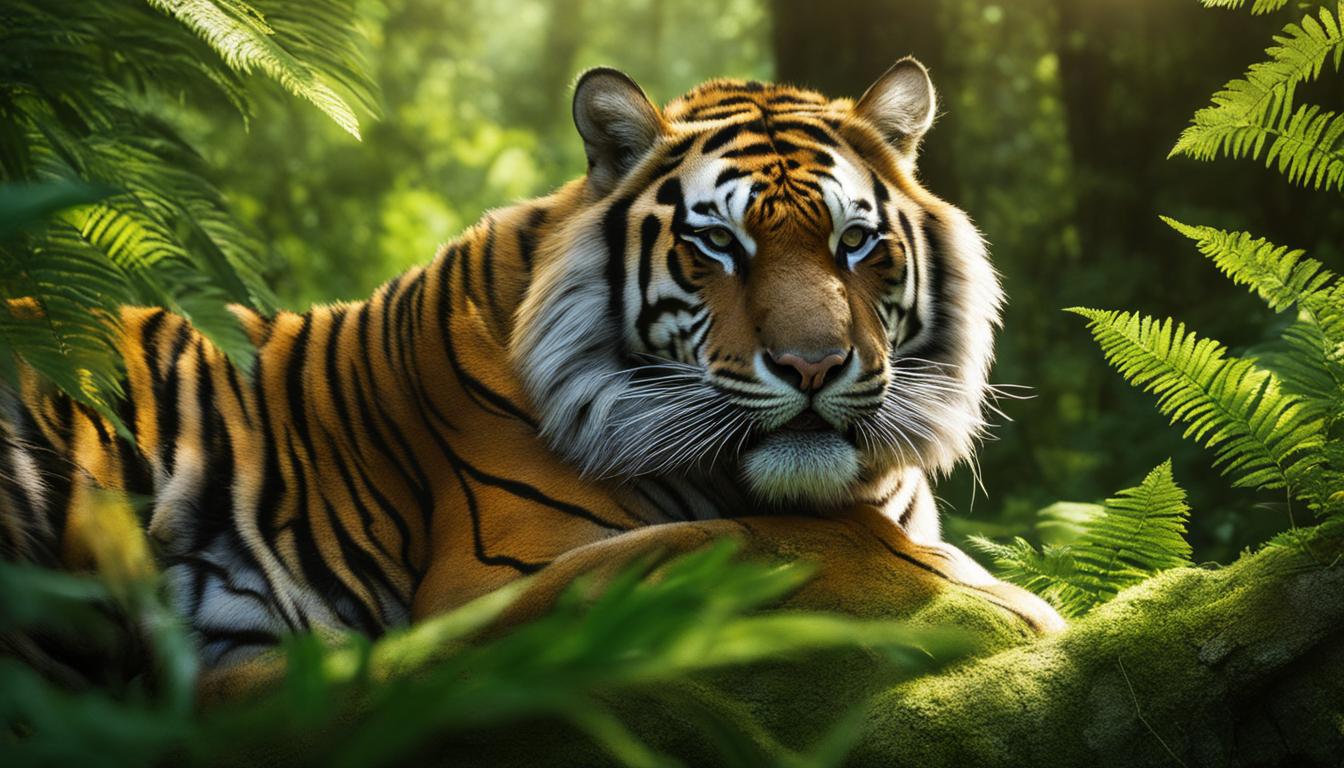Tigers are fascinating creatures known for their sleeping habits. Have you ever wondered how much time tigers spend sleeping? In this article, we will explore the sleep patterns of tigers, their duration of sleep, and why they sleep so much. Understanding tiger sleep is essential for appreciating these magnificent animals and their unique behaviors.
Key Takeaways:
- Tigers sleep for approximately 16 to 20 hours a day.
- They sleep in various locations like rocks, grass, or near their prey.
- Tiger sleep is a way for them to conserve energy and protect their food.
- Factors influencing animal sleep patterns include habitat, anatomy, brain size, and feeding patterns.
- Tigers sleep longer than many other animals, but sleep requirements can vary depending on the environment and captivity.
- Different animal groups have distinct sleep patterns, such as marine animals, amphibians, reptiles, and insects.
Factors influencing animal sleep patterns
Animal sleep patterns are influenced by various factors that can vary across species. Habitat, anatomy, brain size, and feeding patterns all play a role in determining how much sleep an animal needs and how it sleeps. Genetically similar species tend to have similar sleep habits, while different species in the animal kingdom can exhibit a wide range of sleep durations.
The habitat in which an animal lives can greatly impact its sleep patterns. For example, cold-blooded animals such as reptiles have different sleep needs compared to warm-blooded mammals. Animals that live in the water, like whales and dolphins, have unique sleep patterns that allow them to rest while still being conscious of their surroundings. In contrast, land-dwelling animals like tigers have the luxury of finding secure locations to sleep.
Brain size also plays a role in sleep patterns. Animals with larger brains, such as primates, tend to have more complex sleep patterns similar to humans. They experience rapid eye movement (REM) sleep and slow-wave sleep, which are important for cognitive functions. On the other hand, animals with smaller brains, like insects, have simpler sleep patterns characterized by periods of rest and activity.
Factors affecting sleep duration:
- Anatomy (cold-blooded vs. warm-blooded)
- Habitat
- Brain size
- Feeding patterns
In summary, sleep patterns in animals are influenced by a variety of factors, including habitat, anatomy, brain size, and feeding patterns. Understanding these factors can help us appreciate the diversity of sleep habits across different species and shed light on the importance of sleep for animals’ overall well-being.
Table: Sleep Patterns in Different Animal Groups
| Animal Group | Examples | Sleep Patterns |
|---|---|---|
| Marine Animals | Whales, Dolphins | Vertical sleep with one side of the brain awake |
| Amphibians | Frogs, Newts | Deep sleep achieved through burrowing or sitting still |
| Reptiles | Snakes, Crocodiles | Resting with eyes open or sleeping with half of the brain active |
| Insects | Bees, Fruit Flies, Cockroaches | Periods of rest and activity |
Animals that Sleep the Most on Average
While tigers are known for their lengthy sleep periods, they are not the only animals that require a considerable amount of rest. Several other species display high sleep requirements, often sleeping for extended periods. Some of the animals that sleep the most on average include:
- Brown Bat: These nocturnal creatures sleep for approximately 20 hours a day, spending most of their time roosting upside down in caves or trees.
- Lion: Lions are known for their long periods of rest, sleeping for around 19 hours a day. They typically sleep in shaded areas or tall grass to stay cool.
- Giant Armadillo: These impressive creatures sleep for about 18 hours a day, usually in deep burrows that they dig themselves for protection.
- North American Opossum: Opossums spend about 18 hours a day sleeping. They are known to sleep in a curled-up position, both in trees and on the ground.
- Cat: Domestic cats sleep for an average of 14 hours a day, often finding cozy spots in the house or curling up on their owners’ laps.
- Dog: Canines have a slightly lower sleep requirement compared to cats, sleeping for approximately 13 hours a day. They can sleep in various positions, such as curled up, stretched out, or even on their backs with their paws in the air.
It’s important to note that these sleep durations are averages and can vary depending on various factors such as age, health, and environmental conditions. Animals in captivity may have different sleep patterns compared to their wild counterparts due to differences in their daily routines and stress levels. Nevertheless, these animals with high sleep requirements have adapted to prioritize rest, allowing them to conserve energy and maintain optimal health.
“Sleep is the golden chain that ties health and our bodies together.” – Thomas Dekker
| Animal | Sleep Duration (hours/day) |
|---|---|
| Brown Bat | 20 |
| Lion | 19 |
| Giant Armadillo | 18 |
| North American Opossum | 18 |
| Cat | 14 |
| Dog | 13 |
Sleep patterns in different animal groups
Animals from various groups have unique sleep patterns that are adapted to their specific environments and behaviors. Let’s explore the sleep patterns of different animal groups, including marine animals, amphibians, reptiles, and insects.
Marine Animals
Sleep patterns in marine animals are influenced by their aquatic environment. Whales, for example, exhibit an interesting sleep behavior known as unihemispheric slow-wave sleep. This means that only one hemisphere of their brain sleeps at a time, while the other remains awake and active. Whales often sleep by floating vertically in the water, allowing them to rest and breathe simultaneously. Dolphins also adopt a similar sleep pattern, sleeping vertically at the water’s surface with one eye open to remain aware of their surroundings.
Amphibians
Amphibians, such as frogs and newts, display a range of sleep habits. Some species of frogs burrow into the ground during their inactive periods, while others may simply sit still in hidden locations. They achieve deep sleep through these behaviors, which help them conserve energy and stay safe from potential predators.
Reptiles
Reptiles like snakes and crocodiles have unique sleep behaviors. Snakes, for instance, can rest with their eyes open, demonstrating that their state of being awake or asleep may be less clearly defined compared to mammals. Crocodiles have been observed sleeping with half of their brain “on” while the other half rests, allowing them to stay alert to potential threats even while asleep.
Insects
Insects also exhibit sleep patterns similar to humans, with periods of rest and activity. Bees, fruit flies, and cockroaches are known to demonstrate sleep-like behaviors, including reduced movements and heightened response thresholds during their rest periods. However, it is important to note that the sleep patterns of insects are not yet fully understood and are still an area of ongoing research.
By understanding the diverse sleep patterns across different animal groups, we can gain valuable insights into the fascinating world of animal behavior and adaptation.
Sleeping Habits of Tigers
Tigers, known for their impressive strength and elegance, also have fascinating sleeping habits. In the wild, tigers exhibit a diverse range of sleeping behaviors, adapting to different environments and circumstances.
When it comes to sleep positions, tigers can be found resting on rocks or comfortably hidden in tall grass. These positions provide them with a sense of security and camouflage, allowing them to blend seamlessly into their surroundings while they rest.
After making a kill and feeding on their prey, tigers typically choose to sleep near the carcass. This behavior serves multiple purposes. Firstly, it helps them conserve energy, allowing them to rest after a successful hunt. Additionally, by sleeping near their prey, tigers can protect their hard-earned meal from other opportunistic predators in the area.
“Tigers, with their intuitive understanding of their environment, instinctively know how to utilize sleep strategically for their survival.”
Understanding the sleeping habits of tigers is crucial for gaining insights into their behavior and overall well-being. By respecting their need for undisturbed sleep and ensuring the preservation of their habitats, we can contribute to the conservation of these magnificent creatures.
Table: Tiger Sleeping Positions and Behaviors
| Sleeping Position | Behavior |
|---|---|
| Resting on rocks | Tigers sleep comfortably on rocks, often using them as vantage points to survey their surroundings. |
| Hidden in tall grass | Tigers seek shelter in tall grass, using it as a natural camouflage while they rest. |
| Near prey | Tigers sleep near their prey to protect their meal from other predators and conserve energy after feeding. |
Tiger Sleep and Conservation
Tiger sleep plays a vital role in the conservation of these majestic creatures and the preservation of their habitats. Understanding the importance of tiger sleep patterns is crucial for ensuring their well-being and maintaining the balance of the ecosystems they inhabit.
Tigers require long periods of sleep, typically ranging from 16 to 20 hours a day. This extended sleep duration allows them to conserve energy and recharge their bodies for essential activities such as hunting, protecting their territory, and reproducing. By protecting their habitats and ensuring they have undisturbed locations for sleep and rest, we contribute to the overall health and survival of tiger populations.
The relationship between tiger sleep and the ecosystem is intertwined. Tigers are top predators in their habitats, and their presence helps maintain the balance of the food chain. Their sleep patterns ensure they are well-rested and physically prepared to carry out their crucial role in controlling prey populations and preventing overgrazing. By safeguarding tiger habitats, we protect not only these magnificent animals but also the entire ecosystem they belong to.
Conservation efforts should focus on identifying and securing critical tiger habitats, establishing protected areas, and implementing sustainable practices that support their natural sleep patterns. By doing so, we create a conducive environment where tigers can thrive and fulfill their ecological roles as apex predators. The preservation of tiger sleep is not only essential for their survival but also for the preservation of biodiversity and the delicate ecological balance of their habitats.
Tiger Sleep and Ecosystem
Tiger sleep is intricately linked to the ecosystem they inhabit. By maintaining healthy tiger populations and protecting their sleep habitats, we contribute to the overall conservation of biodiversity and the sustainability of natural ecosystems.
| Tiger Sleep and Conservation | Tiger Sleep and Ecosystem |
|---|---|
| Importance of tiger sleep in conservation efforts | Interdependence of tiger sleep and ecosystem health |
| Preservation of tiger habitats for undisturbed sleep | Tiger sleep patterns ensuring ecological balance |
| Sustainable practices to support tiger sleep | Protecting biodiversity through tiger sleep conservation |
Conclusion
Tigers, like many other animals, have a significant need for sleep. They typically sleep for around 18 hours a day, which is necessary for their overall well-being and health. During their rest periods, tigers often choose to sleep near their prey to protect their food and conserve energy. Understanding and respecting their sleep patterns is crucial for their conservation and the preservation of their habitats.
Sleep plays a vital role in animal behavior, including that of tigers. It allows them to recharge their bodies and minds, ensuring they can function properly. Disruptions to their sleep can have adverse effects on their health and overall quality of life. By protecting tiger habitats and providing undisturbed areas for their sleep and rest, we can contribute to the well-being and survival of these magnificent creatures.
As we delve deeper into the understanding of tiger sleep, we gain valuable insights into their behavior and needs. Recognizing the significance of sleep in animal behavior enables us to make more informed decisions regarding conservation efforts. By promoting the protection of tiger habitats and ensuring their undisturbed sleep, we can contribute to the preservation of a balanced ecosystem and the continued existence of these awe-inspiring predators.
Do Lions and Tigers Have Similar Sleeping Habits?
Lions’ sleep patterns revealed: Lions and tigers, both being big cats, share similarities in their sleeping habits. These majestic predators are known to spend a significant portion of their day snoozing, stretching out for up to 20 hours. Their sleeping patterns revolve around conserving energy for hunting and staying alert during their active moments. While both species exhibit similar behaviors, each has its own unique variations in sleep patterns and preferred sleeping spots.
FAQ
How many hours a day do tigers sleep or rest?
Tigers are known for their long periods of sleep or rest, typically ranging from 16 to 20 hours a day.
What factors influence animal sleep patterns?
Sleep patterns in animals are influenced by various factors such as habitat, anatomy, brain size, and feeding patterns.
Which animals sleep the most on average?
Some animals that sleep for extended periods include the brown bat (20 hours), lion (19 hours), giant armadillo (18 hours), North American opossum (18 hours), cat (14 hours), and dog (13 hours).
What are the sleep patterns in different animal groups?
Marine animals like whales and dolphins have different sleep patterns due to their aquatic environment. Amphibians such as frogs and newts have varying sleep habits, and reptiles like snakes and crocodiles have unique sleep behaviors. Insects like bees, fruit flies, and cockroaches also have sleep patterns similar to humans.
What are the sleeping habits of tigers?
Tigers sleep in various locations such as rocks, grass, or near their prey. After making a kill and eating, tigers generally rest or sleep near their prey until they are ready to eat again.
How does tiger sleep relate to conservation?
Understanding tiger sleep patterns is essential for conservation efforts as sleep is crucial for their well-being. By protecting tiger habitats and ensuring they have undisturbed locations for sleep and rest, we can help maintain healthy populations and preserve ecosystems.










